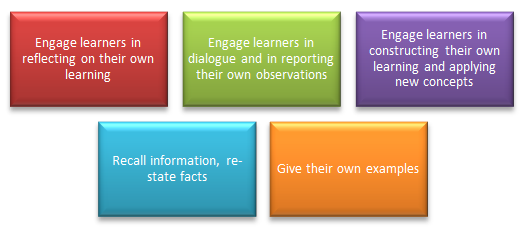Why Learning Activities?
Learning activities provide opportunities for learners to interact with the material being learnt, practice concepts learned and apply them to new situations. Presenting activities as part of the learning materials engages learners to think about what they are learning, which promotes a richer and deeper learning experience.
Importance of Learner Engagement
Think about your experience as a teacher or as an instructor. What happens when you spend all your time talking to your students, transmitting information? Chances are you start to notice that they get distracted... they may start checking their mobile phones, or checking their watches. In the case of online courses, if your course is only composed of blocks of descriptive text, chances are your student will get tired of reading and leave the course altogether. Well, this happens because they are not engaged in the learning process.
How to Engage Learners
So how do we engage learners? Well, we do that by making them active participants in the learning process. And we achieve this by planning contextual and meaningful learning activities for students to do throughout the course. These activities can have a variety of aims:

Depending on what you want to attain with a specific learning activity for your course, you will decide on what type of activity you want to engage your learners in. And don't forget... the learning activity must be aligned with the learning objectives.

Example
Say for example that I am teaching an online course on Auto Mechanics. One of the topics I cover is Brake Systems. My learning objective states that by the end of my lesson on Brake Systems, learners will be able to:
- List the two characteristics of hydraulic brakes in sedan models.
The aim of my activity is to have students recall information and re-state facts. Therefore, I choose to create a multiple choice question with five answer choices, with characteristics of both hydraulic and line brake systems. I design the answer choices to include two characteristics of hydraulic brakes and to accept multiple selection of answer choices. I set the correct choices to the two characteristics of hydraulic brake systems.
If the learning outcome had been to:
- discuss the characteristics of hydraulic and line brake systems.
the aim for the activity would be to engage learners in dialogue, therefore I would create a discussion forum where students could discuss the characteristics of brake systems.
So, as you see, by aligning the learning activities with the learning objectives and considering what the aim for the activity is, I can easily get ideas for what type of activity I should design to engage my learners and create a deeper, more meaningful learning experience. As you go through the process of planning learning activities, keep in mind that this is an iterative stage: as you come up with learning activities, you may have to revise the learning objectives and vice-versa. As this stage nothing is written in stone, and the process allows you to narrow down exactly what needs to be taught and how.

Activity
- In the course plan document (learning activities column), briefly describe what learning activities you are planning to help learners attain the learning objectives.
